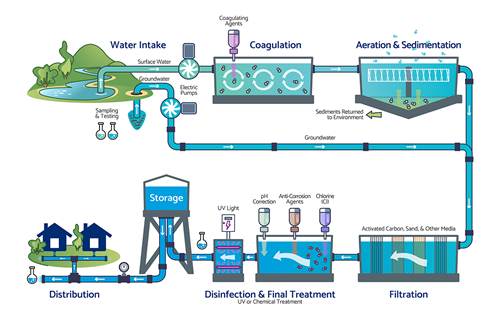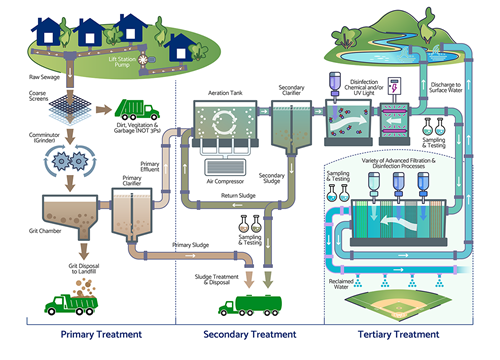How Utility Systems Work
Your water and wastewater systems are an exceptionally small part of our planet’s hydrologic (water) cycle. Yet collectively, our use and treatment of water has an enormous impact on our environment and wellbeing.
Water Utility Systems
The journey drinking, or potable, water takes to reach your tap can be a long one. In a regulated system such as yours, that involves considerable infrastructure, skilled operators, and numerous checks along the way to ensure it reaches your tap as clean, safe, reliable drinking water.
Drinking Water Treatment
Simplified Process

click to enlarge
Sources of Drinking Water
Your drinking water’s journey starts at one of two sources:
Groundwater
Pumped from aquifers (underground layers of porous rock) to the surface through wells. Groundwater was traditionally considered to be of higher purity than surface water, however; chemical contamination is an increasing concern across the US.
Surface Water
Pumped from freshwater lakes and rivers. Surface water is more susceptible to contamination, so usually requires more treatment.
You can learn where your drinking water comes from in your community’s Water Quality Reports.
It’s important to note all drinking water contains some naturally occurring elements that aren’t harmful to health, and some provide low levels of nutritional value and enhance its taste.
Treatment of Groundwater
Water is pumped from the well to the water treatment plant – sometimes a distance of several miles. Once it reaches the treatment plant, it’s passed through mechanical filters to remove particles, such as organic matter, silt, clay, iron, and manganese. If necessary, it’s passed through a chlorination or UV process to remove any bacteria, viruses, and protozoan parasites. Groundwater is regularly tested at source, and after it has passed through the treatment process.
Treatment of Surface Water
Surface water is more susceptible to contamination, so usually requires more complex treatment. Water is first pumped from reservoirs, lakes, or rivers; normally from depth where it is less disturbed. Once it reaches the water treatment plant, it passes through a sedimentation and aeration process. Aeration releases any volatile gases, and coagulating agents help filter out small particles in large settling tanks. It’s then sent through a series of long filtration tanks, which use gravel, sand, or activated carbon to further remove particles and pollutants. Finally, it passes through a chlorination and/or UV process to remove any remaining bacteria, viruses, and protozoan parasites. Surface water is regularly tested at source and throughout the treatment process.
Storage & Distribution
Once treated, drinking water is stored in large tanks and/or water towers. This ensures a reliable and constant supply for the community’s needs, including fire suppression (fire hydrants and reservoirs). The large volume of these tanks also increases the water’s pressure, reducing the need for additional pumps in the system.
From the storage tanks, an extensive network of watermains, made from iron or PVC, deliver clean pressurized water to homes and businesses. Watermain networks run under streets and sidewalks and can be many miles longer than street infrastructure. Customers connect, or “tap” into these public watermains through private service lines. Service lines often have a shut-off valve, or “curb stop”, and water meter installed before the line enters the building, though this can vary by jurisdiction and age of the installation. More information about service lines and meters can be found on the Water Meters & Leaks and Lead & Lead Service Lines pages.
Wastewater Utility Systems
Wastewater is any water that has been used in some way by humans and which must be treated (cleaned, purified) before it’s returned to the natural environment. Wastewater includes everything flushed down drains and toilets, collected from runoff, storm drains, car washes, and an infinite number of commercial uses. When wastewater contains human waste, it’s called “sewage”, and when it’s returned to the natural environment is often called “effluent”.
The importance of collecting and disposing of wastewater was recognized by many early urbanized societies, not only for cleanliness, but because they knew it helped reduce disease. As the science and technology of wastewater treatment evolved, we started taking it more for granted. Today, we rarely think about what happens to what we flush down the drain or toilet, and that has its unintended consequences. Learn more about the 3 Ps of Flushing.
In general, the larger a community, the greater is the need, ability, and social imperative to invest in higher levels of wastewater treatment. But regardless of a community’s size, regulations ensure that accepted wastewater treatment standards are applied uniformly across all jurisdictions.
Wastewater Collection
Wastewater is collected by networks of sewer mains that run under streets and sidewalks. Like water systems, this unseen infrastructure is very extensive. Sewer main pipes are made of various durable materials, with the largest being of concrete. Unlike potable water systems that operate under pressure, sewer systems largely rely on gravity to move sewage to wastewater treatment plants. As such, treatment plants are usually located in the lowest areas of a community and close to rivers or lakes to aid in the safe and efficient disposal of treated water. Pumps or “lift stations” may be required to keep wastewater flowing from low lying areas.
Wastewater Treatment
In the U.S., wastewater collection and disposal is strictly regulated. The extent and types of treatment used depend largely on the volumes of effluent involved and the ability of the natural environment to absorb and neutralize it. This is because effluent is typically discharged into nearby natural or manmade bodies of water and water courses. The level of wastewater treatment falls into three broad groups: Primary, Secondary, and Tertiary.
Wastewater Treatment
Simplified Process

click to enlarge
Primary Wastewater treatment
Primary treatment uses course filters to remove most solids, which can account for 35 percent of urban wastewater. This removes plant matter, dirt, and garbage, which can be disposed of in landfill. Water is then passed through settling tanks (or clarifiers), which allows sludge to settle on the bottom and scum to form on top. These pollutants are then separated and removed.
Primary treatment removes a considerable number of harmful substances from wastewater, but it is not enough to ensure that all harmful pollutants have been removed.
Secondary Wastewater Treatment
Secondary treatment uses bacteria to further remove pollutants still present after primary treatment. This is done by introducing oxygen and bacteria, which helps digest the pollutants faster. Settling tanks are used again to remove remaining sludge and scum to produce water that is 90 to 95 percent free of pollutants. Many smaller treatment plants discharge the water at this point, while others will apply further mechanical filtration, and disinfection with chlorine, ozone, or ultraviolet (UV) light.
Secondary treatment is employed in most medium and large urban wastewater systems. It produces a high and safe level of water purity that can be safely returned to the environment.
Tertiary Wastewater Treatment
Tertiary treatment removes dissolved substances, such as color, metals, organic chemicals and nutrients like phosphorus and nitrogen. More steps, time, and treatment plant infrastructure are needed for tertiary treatment, and some newer technologies are quite sophisticated. The result is wastewater that achieves a high level of purity and can even be used as Reclaimed Water (below).
Because of the large investment needed in treatment plant infrastructure and operational expertise, tertiary treatment is only practical in larger systems, or combined systems feeding into one plant.
In all three levels of treatment, solids (sludge, scum) are separated. These solids are treated separately from the liquid waste, and through various processes can be purified and made safe. Depending on the level of treatment, the solid waste can be sent to landfill or even used safely in agricultural applications.
Reclaimed Water
Reclaimed (recycled or reuse) water is wastewater treated to the tertiary treatment level described above or even further. Generally, quality standards are higher, which is achieved with longer filtering and settling processes, and/or the application of chemicals (chlorine, ammonia, lime, and others). This creates a safe product that can be used for irrigation, agriculture, cooling, car washes, and other commercial applications. It must meet strict federal and state water quality standards and can never be used for human consumption. Reclaimed water systems are kept entirely separate from drinking water systems and can be easily identified by their purple-colored pipes.
Reclaimed water has gained acceptance in the U.S. over the last few decades and is now seen as a necessity to mitigate the effects of climate change and water scarcity. You can learn more about water conservation and water scarcity on our Conservation and Environment pages.
Learn More
You can find articles on water and wastewater topics on our News pages. And of course, we’re always happy to answer specific questions you may have about your services, our installations, and processes. Please contact Customer Service.
Online resources regarding water and wastewater treatment technology, health and the environment, regulation, and public policy, are endless, but a good place to start is the U.S. Environmental Protection Agency’s (EPA) water resources pages, or your state government website.